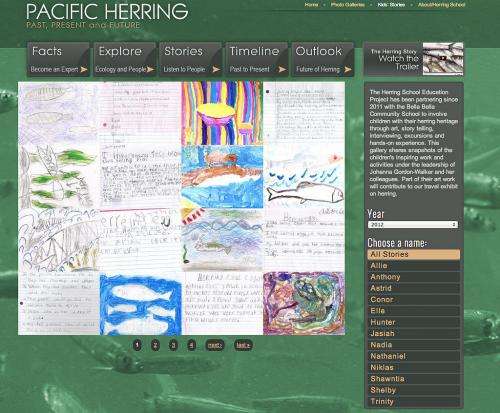New website engages viewers in herring story

Like a fishing net, a new website, created by a Simon Fraser University archaeologist and a multimedia consultant, captures viewers and draws them into an interactive multimedia window onto Pacific herring's past, present and future.
SFU professor Dana Lepofksy, drawing on her understanding of herring's importance to coastal First Nations, and Greencoastmedia videographer Mark Wunsch, drawing on his multimedia storytelling talent, have stitched together the Pacific Herring website.
Its hundreds of video and photographic snippets spin a true life tale about herring as a bait fish, a commodity in reduction plants, a cultural symbol, an ecological lynchpin and a dwindling species.
In pursuit of fresh material for the site, Wunsch shot video underwater, on research field trips, on commercial fishing boats and in the air on a federal fisheries survey flight. Lepofsky travelled up and down B.C.'s central coast gathering interviews with Aboriginal people.
Viewers, regardless of age, background or education, can venture into a world of facts, discoveries, issues and viewpoints about herring that is as complex or simple as they want through this website.
The collaborators profess no other website weaves together such a stimulating yet simply told tale about herring's cultural and ecological importance.
"Original knowledge is available through interview excerpts with First Nation elders, fishermen and scientists," notes Wunsch. "These short clips can be accessed through a zoomable map of the coast as well as throughout the site's other pages."
Lepofsky and Wunsch envisioned a website as the best vehicle for sparking public interest in herring because it allows for diverse voices, images, videos and facts to be integrated into one place.
Born out of the duo's collaboration with the Heiltsuk First Nation in 2010 and the launch of the Hakai Herring School, a research and community outreach project, the Pacific Herring website's purpose is an ambitious one.
We aim to "make herring a household word," says Lepofsky. "We want people in coastal B.C. to be thinking about herring as much or more than salmon. Given that herring is a foundation of our coastal ecosystems, and that herring populations are declining, it makes sense everyone should be thinking about this fish."
And through an outreach program they started at an Aboriginal community school in Bella Bella, Lepofsky and Wunsch have instigated a wave of intergenerational sharing of herring knowledge on the Pacific Herring website.
Inspired by interviews they conducted with their parents and grandparents about the traditional uses of herring in Aboriginal culture, the school children have created art and prose that has been posted on the website.
"The conversation will continue when the kids click on their images on the website and share them back with their family," says Lepofsky. "The conversation will then naturally spread from within families, to among families with the community, and then among communities all along the coast."
The website is a living document. Lepofsky and Wunsch invite the public to share their own observations and historical photos to further enrich general knowledge about herring on our coast. See Pacific Herring website
Provided by Simon Fraser University

















